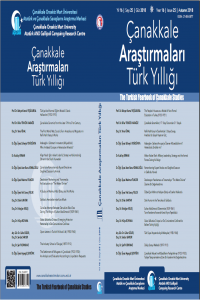Öz
The purpose of this paper is to give a factual history of the establishment of the Houses. The People’s Houses (Halkevleri) were founded in 1932 as cultural and political centres with the aim of educating the people in accordance with the nationalist, secularist and populist ideas of the new Republic. Their specific aim was to establish and reinforce a national culture based on Turkish folklore, teach the Republican principles, raise literacy rates and improve the living standards of the people. After nearly two decades of functioning, the People’s Houses were closed in 1951 by the Democrat Party. Although the People’s Houses were organised and conducted by the Republican People’s Party, the only political party in modern Turkey until 1946, they did not represent such a complete innovation in Turkish life as was often assumed. After the Young Turk revolution in 1908, thirteen social centres, called “Türk Ocağı” or “Turkish Hearth”, were established in various parts of the country to educate the common people in Turkish culture. Not all of these centres were successful, according to any standard; and they fell far short of the standard later set by the People’s Party. But those which survived the First World War were taken over by the People’s Party in 1923 and, after a complete reorganisation, renamed People’s Houses in 1932. Since they were organs of a political party, the People’s Houses were primarily centres of political propaganda. However, it must be remembered that the propaganda of the People’s Party was much wider in scope than that of a political party operating in a country with is a tradition of party conflict. Namely, the politics of the People’s Party were essentially national politics; its propaganda, rather than being directed to the criticism and ousting of other parties, aimed exclusively at national consolidation. In spite of the greatest temptations, the new Turkish Republic refused to abandon this enlightened view of propaganda, as testified by the multifarious activities of the People’s Houses. The Halkevleri played an enormous role in the life of the new Turkish republic. If not in their origin, then in their activities, and even more so in their achievements, they were unique and exemplary institutions, without which even so great a leader as Ataturk might have been unable to carry out the far-reaching changes that he did.
Anahtar Kelimeler
People’s Houses People’s Halls Turkish Hearths Halkevleri Türk Ocakları
Kaynakça
- 7. Bibliography 7.1. Archival sources All references to sources prefixed by FO and FCO refer to documents held at the UK National Archives, formerly the Public Record Office (PRO). The following files have been consulted: FO624/32, “Report on the Turkish Halkevleri” by E. W. E. Tomlin, British Council Reports, No: 319, British Embassy, Baghdad, 1943. FO371/48799, FCO13/569, FCO13/681, FO371/33380, FO115/3871, FO115/3870. 7.2. Books & Articles Arıkan, Zeki, “Halkevlerinin Kuruluşu ve Tarihsel İşlevi”, Ankara Üniversitesi Türk İnkılap Tarihi Enstitüsü Atatürk Yolu Dergisi, Cilt: 6, Sayı: 23, s. 261-281. CHP, Halkevleri 1940, Ulusal Matbaa, Ankara 1940. CHP, Halkevleri Talimatnamesi, Hâkimiyeti Milliye Matbaası, Ankara 1932. CHP, Halkevleri ve Halkodaları (1932-1942), Alaeddin Kıral Basımevi, Ankara 1942. Çavdar, Tevfik, “Halkevleri”, Cumhuriyet Dönemi Türkiye Ansiklopedisi, Cilt: IV, s. 878-884. Çeçen, Anıl, Atatürk’ün Kültür Kurumu, Halkevleri, Cumhuriyet Kitapları, Ankara 2000. Duman, Selçuk, Modern Türkiye’nin İnşasında Halkevleri ve Sivas Halkevi Örneği, Berikan Yayınları, Ankara 2013. Durak, Gökhan, “Atatürk’ün Halkçılık Anlayışı ve Halkevleri”, Akademik Sosyal Araştırmalar Dergisi, Yıl: 2, Sayı: 8 (Aralık 2014), s. 420-435. Erdal, İbrahim, Halkevlerinin Kuruluşu, Yapısı ve Yozgat Halkevi, 1932-1951, Siyasal Kitabevi, Ankara 2013. Güneş, Müslime, “Adnan Menderes ve Halkevleri”, Çağdaş Türkiye Araştırmaları Dergisi, XII/25 (2012-Güz), s. 141-155. Kara, Âdem, Halkevleri, 1932-1951, 24 Saat Yayıncılık, Ankara 2006. Karpat, Kemal, “The Impact of the People’s Houses on the Development of Communication in Turkey, 1931-1951”, Die Welt des Islam, Volume: 15, Issue: 1, P. 69-84. Behçet Kemal YEŞİLBURSA 17 Karpat, Kemal, “The People’s Houses in Turkey: Establishment and Growth”, Middle East Journal, Volume: 17, No: ½, (Winter-Spring 1963), p. 55-67. Olgun, Kenan, Yöresel Kalkınmada Adapazarı Halkevi, Değişim Yayınları, İstanbul 2008. Özdemir, Yavuz ve Elif Aktaş, “Halkevleri, 1932’den 1951’e”, A.Ü. Türkiyat Araştırmaları Enstitüsü Dergisi (TAED), 45, (Erzurum 2011), s. 235-262. Şimşek, Sefa, Halkevleri 1932-1951, İstanbul 2002. Toksoy, Nurcan, Halkevleri, Orion Yayınevi, İstanbul 2007. Yerlikaya, Neşe Gürallar, Halkevleri: İdeoloji ve Mimarlık, İletişim Yayınları, İstanbul 2003. Zeyrek, Şerafettin, Türkiye’de Halkevleri ve Halkodaları, Anı Yayınları, Ankara 2006.
Ayrıntılar
| Birincil Dil | Türkçe |
|---|---|
| Bölüm | Makaleler |
| Yazarlar | |
| Yayımlanma Tarihi | 29 Ekim 2018 |
| Yayımlandığı Sayı | Yıl 2018 Cilt: 16 Sayı: 25 |


